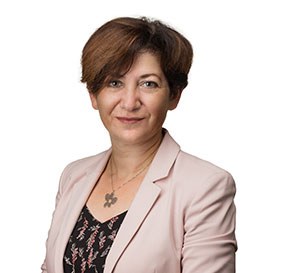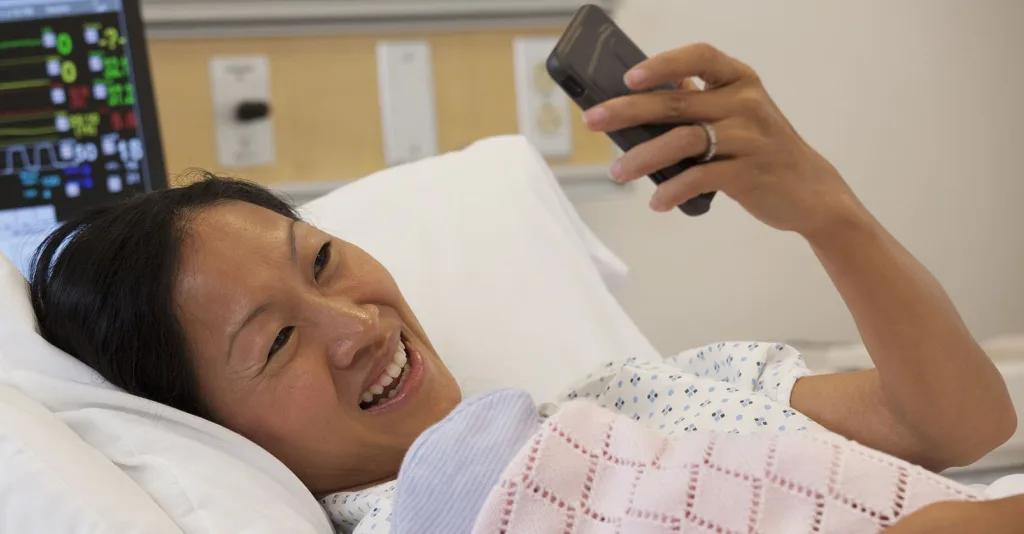At the beginning of March 2020, Susan Murphy, BSN, MS, RN, had to think on the fly about how to restore the connection hospitalized patients had lost because of COVID-19.
[caption id="attachment_76871" align="alignleft" width="180"] Susan Murphy, RN[/caption] Murphy, the chief experience officer at UChicago Medicine, said visiting hours stopped abruptly but patients' needs for human connection remained. "That was a pretty traumatic day," Murphy said. "We had to go to every room and tell visitors they couldn't come back and weren't sure when they could (return)."
Susan Murphy, RN[/caption] Murphy, the chief experience officer at UChicago Medicine, said visiting hours stopped abruptly but patients' needs for human connection remained. "That was a pretty traumatic day," Murphy said. "We had to go to every room and tell visitors they couldn't come back and weren't sure when they could (return)."
Connection Lost and Found
Emotional support and alleviation of fear and anxiety along with involvement of family and friends are two principles of patient-centered care, according to research from Harvard Medical School. Murphy and her team came up with how they could use existing technology to address those principles that would allow patients to maintain contact with staff inside the hospital and loved ones outside the walls. They used the hospital's existing Vocera Care Experience technology, which is a virtual voice-capturing tool that staff use when rounding to document and track patients' experiences. But instead of going into patients' rooms during the pandemic, hospital staff used the technology to call patients in their rooms every day to check in and see how they were doing. These weren't clinical calls, according to Murphy. Rather, staff asked patients how they were feeling emotionally during the uncertainty of the pandemic. Murphy calls it human-centered care. [caption id="attachment_76869" align="alignright" width="400"] Click here for a downloadable pdf.[/caption] Staff also provided iPads to patients in their rooms, so the patients could use them to communicate with loved ones via Zoom, FaceTime, or another platform.
Click here for a downloadable pdf.[/caption] Staff also provided iPads to patients in their rooms, so the patients could use them to communicate with loved ones via Zoom, FaceTime, or another platform.
"What we realized was they wanted to make sure their voices were being heard by the organization and also by those they love," Murphy said.
When Patient-Centered Care Meets Technology
Patient-centered care isn't about technology itself. It's about how nurses and others use the technology to achieve the kindness and compassion patients want in a healthcare setting, according to Murphy. Harvard Medical School, on behalf of the Picker Institute and The Commonwealth Fund, compiled data from interviews with patients, family members, physicians, non-physician hospital staff, and literature reviews to define eight principles that characterize what patients want most in their healthcare experience. As mentioned previously, emotional support and alleviation of fear and anxiety, along with involvement of family and friends, are two of those principles. According to Harvard Medical School, the other six principles include:
- Respect for the patients' values and preferences
- Coordination and integration of care
- Information, communication, and education
- Physical comfort
- Timely access to care
- Continuity and secure transition between healthcare settings
Tools That Help Nurses, Patients
Technology helps in all types of care settings to improve patient-centered care. Video chat, for example, allows patients to connect face-to-face with providers through their mobile devices, according to Becky Waldman, RN, vice president of clinical service and quality assurance with WINFertility. She oversees the national fertility benefit management company's nurses specializing in fertility care. And nowadays, healthcare companies such as WINFertility can use outcome data analysis to better educate patients. "Twenty-one years of patient data has been analyzed allowing WIN to identify probable outcomes under certain circumstances," Waldman said. "This supports our nurses in patient education for improved journey choices." [caption id="attachment_76872" align="alignleft" width="220"] Faina Kaganov, RN[/caption] The Allure Group, which manages six New York nursing and rehabilitation centers in Brooklyn and Manhattan, uses complementary technologies to better respond to patients' needs, according to Faina Kaganov, RN, MBA-CA, CLNC, the company's chief clinical officer. ConstantCare e-Vitals technology helps alert nurses to worrisome changes in patients' vital signs. "It provides an immediate alert when the nurse is obtaining vital signs," Kaganov said. If there is a difference in heart rate from the patient's baseline, the machine will ask the nurse, ''Would you like check or document?' Instead of just pushing it in the electronic health record, it brings to nurses' attention that something is not right. "It helps to give nurses information about potential infection or dehydration or anything else," Kaganov said. Staff use the telehealth provider TeleHealth Solution to diagnose and treat patients. "When nurses are alerted about early changes in conditions, it helps them to be more proactive, to get in touch with physicians during normal business hours or with TeleHealth Solution," Kaganov said. "It benefits the residents. It benefits the nurses for being on high alert for early changes in condition and prevents hospitalizations."
Faina Kaganov, RN[/caption] The Allure Group, which manages six New York nursing and rehabilitation centers in Brooklyn and Manhattan, uses complementary technologies to better respond to patients' needs, according to Faina Kaganov, RN, MBA-CA, CLNC, the company's chief clinical officer. ConstantCare e-Vitals technology helps alert nurses to worrisome changes in patients' vital signs. "It provides an immediate alert when the nurse is obtaining vital signs," Kaganov said. If there is a difference in heart rate from the patient's baseline, the machine will ask the nurse, ''Would you like check or document?' Instead of just pushing it in the electronic health record, it brings to nurses' attention that something is not right. "It helps to give nurses information about potential infection or dehydration or anything else," Kaganov said. Staff use the telehealth provider TeleHealth Solution to diagnose and treat patients. "When nurses are alerted about early changes in conditions, it helps them to be more proactive, to get in touch with physicians during normal business hours or with TeleHealth Solution," Kaganov said. "It benefits the residents. It benefits the nurses for being on high alert for early changes in condition and prevents hospitalizations."
Top Trends Driven by the Pandemic
Mainstreaming telehealth is among the top healthcare trends in 2020 that has accelerated because of the pandemic, according to a Forbes.com report. "Many new health professionals entering the workforce are ready and willing to break down the barriers to speed up the use of technology for patient care," according to Forbes. "It is an essential step in the direction to drive access and equity for individuals who may not have access to treatment. These new opportunities can provide a positive pathway for many who may not be able to visit healthcare centers and have challenges gaining access to treatment. More framework needs to be built to support the systems for patients, but the doors have opened." Glenda Hargrove, BSN, RN, a registered nurse care coordinator in telehealth at an Atlanta-based hospital said telehealth with video visits through an app or secured web link are convenient and easier for patients. "They don't have to drive to appointments or sit in a waiting room," she said. "It is becoming a preference for many of our patients." The need to use technology to improve patient-centered care likely will be magnified in the foreseeable future because of COVID-19, according to UChicago's Murphy. "I think the days are gone for a while where there are 10 visitors in a room or a bunch of residents and doctors rounding in patients' rooms," she said. "So how can we utilize technology to not make it feel cold and done by a computer or laptop ... but to still make it compassionate? I think that's going to be the challenge and the balance."






